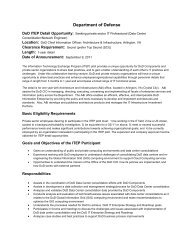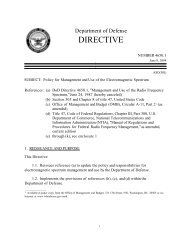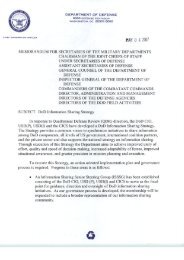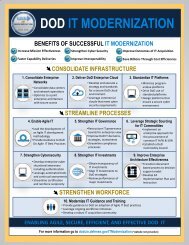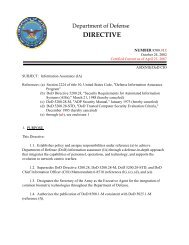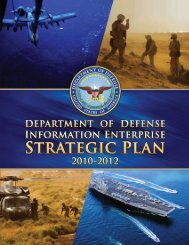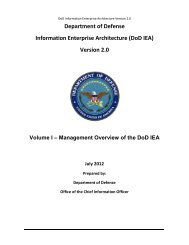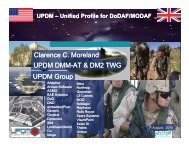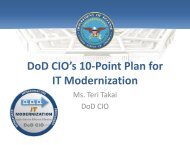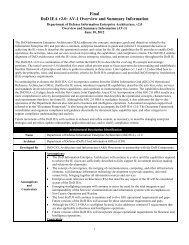DoD Architecture Framework Version 1.5 - Chief Information Officer
DoD Architecture Framework Version 1.5 - Chief Information Officer
DoD Architecture Framework Version 1.5 - Chief Information Officer
Create successful ePaper yourself
Turn your PDF publications into a flip-book with our unique Google optimized e-Paper software.
A federated architecture is a distributed strategic information asset base, which defines the<br />
mission, the information and technologies necessary to perform the mission, and the transitional<br />
processes for implementing new technologies in response to the changing mission needs. It<br />
provides a framework for enterprise architecture development, maintenance, and use that aligns,<br />
locates, and links disparate architectures and architecture information via information exchange<br />
standards to deliver a seamless outward appearance to users. A federated architecture approach<br />
recognizes the uniqueness and specific purpose of disparate architectures and allows for their<br />
autonomy and local governance while enabling the enterprise to benefit from their content. 8<br />
Federation is a way to organize an enterprise’s body of knowledge (architecture) about its<br />
activities (processes), people, and things within a defined context and current/future<br />
environment. Federation allows the architecture user a means to examine the enterprise from all<br />
aspects of the doctrine, organization, training, materiel, leadership and education, personnel, and<br />
facilities (DOTMLPF) concept. The Department has chosen this approach as the new GIG<br />
architecture paradigm 9 and seeks to facilitate the federation of architectures by:<br />
• Identifying a core set of metadata for all architectures that enables<br />
discovery of architecture information<br />
• Establishing an architecture Community of Interest (COI) to develop<br />
information sharing agreements that make architectures accessible<br />
throughout the enterprise<br />
• Establishing the <strong>DoD</strong> <strong>Architecture</strong> Registry System to support linking and<br />
discovery of federated architectures<br />
• Semantically aligning disparate architectures to support understanding and<br />
interoperability across communities<br />
Both types of architectures are of value to the user. Integrated architectures enable a broader<br />
perspective of the mission by representing architecture data elements through multiple views.<br />
Federated architectures support decision making at program, <strong>DoD</strong> Component, mission, and<br />
enterprise levels by linking architectures across the enterprise, providing a holistic enterprise<br />
view that allows for the assessment of interoperability, identification of duplication and gaps, or<br />
determination of reusability. Both integrated architectures and federated architectures support<br />
net-centricity by enabling the semantic and structural alignment of data across disparate<br />
architectures in a useful manner for the improved reliability and efficiency of decisions, thus,<br />
resulting in improved mission outcomes.<br />
1.3 FRAMEWORK OVERVIEW<br />
An architecture framework provides guidance and rules for structuring, classifying, and<br />
organizing architectures. An architecture description is a representation of a defined domain, as<br />
of a current or future point in time, in terms of its component parts, how those parts function, the<br />
rules and constraints under which those parts function, and how those parts relate to each other<br />
and to the environment.<br />
The architecture framework for the <strong>DoD</strong> consists of two layers: data and presentation. Figure<br />
1-2 illustrates these layers.<br />
8 <strong>DoD</strong> Federated Joint <strong>Architecture</strong>s Working Group (FJAWG) recommendation, Dec 2005.<br />
9 The <strong>DoD</strong> is currently developing an Enterprise <strong>Architecture</strong> Federation Strategy that further describes this approach.<br />
1-6




